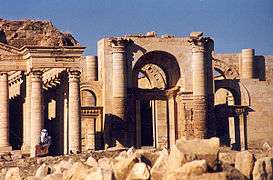Kingdom of Araba
The Kingdom of Araba (or simply Araba) (Hatran Aramaic: 𐣠𐣣𐣡𐣩𐣠 'RBY') was a 2nd-century CE Arab kingdom located between the Roman Empire and the Parthian Empire, mostly under Parthian influence, located in modern-day northern Iraq.[1]
Kingdom of Araba | |||||||||
|---|---|---|---|---|---|---|---|---|---|
| 2nd century CE–241 | |||||||||
 Hatra area of influence | |||||||||
| Status | Kingdom | ||||||||
| Capital | Hatra | ||||||||
| Common languages | Aramaic (Hatran) | ||||||||
| Religion | |||||||||
| Government | Monarchy | ||||||||
| King | |||||||||
| History | |||||||||
• Established | 2nd century CE | ||||||||
• Fall of Hatra | 241 | ||||||||
| |||||||||
| Today part of | |||||||||
| Historical Arab states and dynasties | ||||||||||||||||||||||||||||||||||||||||||||||||||||||||||
|---|---|---|---|---|---|---|---|---|---|---|---|---|---|---|---|---|---|---|---|---|---|---|---|---|---|---|---|---|---|---|---|---|---|---|---|---|---|---|---|---|---|---|---|---|---|---|---|---|---|---|---|---|---|---|---|---|---|---|
 | ||||||||||||||||||||||||||||||||||||||||||||||||||||||||||
|
Ancient Arab States
|
||||||||||||||||||||||||||||||||||||||||||||||||||||||||||
|
Arab Empires
|
||||||||||||||||||||||||||||||||||||||||||||||||||||||||||
|
Eastern Dynasties
|
||||||||||||||||||||||||||||||||||||||||||||||||||||||||||
|
Western Dynasties
|
||||||||||||||||||||||||||||||||||||||||||||||||||||||||||
|
Arabian Peninsula
|
||||||||||||||||||||||||||||||||||||||||||||||||||||||||||
|
East Africa
|
||||||||||||||||||||||||||||||||||||||||||||||||||||||||||
|
Current monarchies
|
||||||||||||||||||||||||||||||||||||||||||||||||||||||||||
The city of Hatra was probably founded in the 3rd or 2nd century BCE, under the Seleucid kingdom.[1] Arabs were common in Mesopotamia at the time of the Seleucids (3rd century BC).[2] In the 1st and 2nd century, Hatra was ruled by a dynasty of Arabian princes.[1] It rose to prominence as the capital of Araba and became an important religious center as a result of its strategic position along caravan trade routes.[1]
Araba is one of the first Arab states to be established outside of Arabia, preceded by the Kingdom of Osroene (132 BC–216 AD) and the Kingdom of Emesa (64 BCE–300s CE), and followed by the Ghassanids (220–638) and the Lakhmids (300–602), buffer states of the Roman and Sassanid Empires, respectively.[2]
Hatra had withstood sieges by Roman emperors Trajan and Septimius Severus and the Sasanian king Ardashir I. The kingdom finally fell after the capture of Hatra by the Sasanians under Shapur I, who destroyed the city.[3]

See also
- Ghassanids
- Lakhmids
- Arbayistan (363–638)
- Roman-Parthian Wars
References
- "Araba (ancient state, Iraq)". Britannica. Retrieved 2008-10-15.
- Ramirez-Faria, 2007, p. 33.
- Whitworth, Patrick (2018). Suffering and Glory: The Church from the Apostles to Constantine. Sacristy Press. p. 212. ISBN 9781910519929.
Bibliography
- Ramirez-Faria, Carlos (2007). Concise Encyclopaedia of World History. Atlantic Publishers & Distributors. ISBN 978-81-269-0775-5. ISBN 81-269-0775-4.